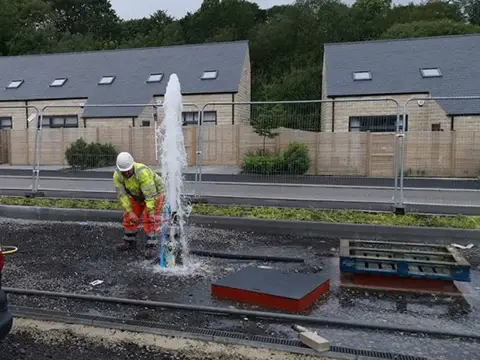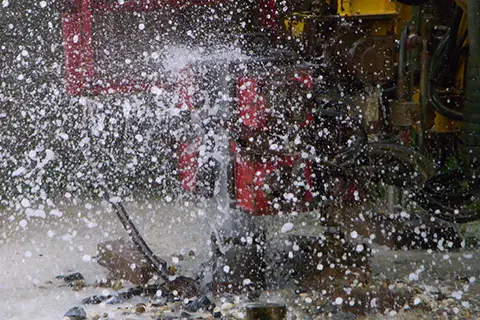Borehole installation: the step-by-step guide
Although all borehole projects are tailored to each individual client’s needs, our 7-step installation methodology should make understanding the entire process simpler.
Borehole installation: the step-by-step guide
At Igne, we have over 70+ years’ experience drilling and maintaining commercial and residential boreholes for water and ground source heating solutions.
We’re proud to serve our residential clients who rely on us to maintain self-sufficiency, the rural and agricultural communities that depend on us for reliable water supplies for their livestock and crops, and we’re equally proud to work with commercial clients including Coca-Cola, Severn Trent, and Welsh Water.
Although all borehole projects are tailored to each individual client’s needs, our 7-step installation methodology should make understanding the entire process simpler.
Step 1: consultation
Whether you want to be self-sufficient or stay off grid, you’re a farmer dreading another drought or a heavy-water-using business needing to slash costs, we understand that you may have a lot of questions about the borehole installation process.
How much will it cost, how long will it take, do you guarantee to find water? We offer free, no obligation consultations for you with our expert team – they can answer typical questions like these, and help you understand exactly how a borehole could benefit you dependent upon your particular circumstances and requirements.
During the initial consultation, we’ll explain the installation process and go over any considerations you may not have thought of which could help you make a decision – such as the likely timeframe before you’re cost neutral and making significant savings, and even how we can access restricted sites or deal with issues such as artesian pressure.
Step 2: water borehole prognosis
A water borehole prognosis is an independent hydrogeological survey.
This prognosis highlights the potential quantity and quality of the water you can expect to enjoy from your borehole.
The prognosis is an essential requirement prior to any drilling taking place – whilst it’s not an exact guarantee of finding water, it does ensure we protect your time and investment.
This survey provides insight into:
- the nature of the drilling site
- the predicted depth at which water will be found
- likely water quality
This information enables us to design a bespoke borehole solution for your site.
Although a positive prognosis cannot guarantee we will successfully find a suitable water source, it provides invaluable insights that highlight any challenges that may be encountered. This enables us to plan ahead to avoid issues.
This prognosis provides both you and us with all the information needed to determine the best next steps and project timelines.
Step 3: drilling and lining your borehole
We maintain our own in-house fleet of drilling rigs and associated equipment. This means when you choose us for your borehole installation, we manage the process from start to finish. You’re not at the mercy of third-party equipment suppliers and the vagaries of their timelines!
What’s more, our experienced team has all the capabilities and expertise to handle the drilling and lining of your borehole.
The depth we drill to will be dependent on information provided by step 2, the hydrogeological survey.
Once the drilling process is complete, your borehole will be lined to ensure efficient filtering of the water.
There will also be an upper liner near the surface that protects your well against the intrusion of surface water and contaminants. This is critical to protect the quality of your water, and ensure sadly common winter flooding from interrupting your supply.
Step 4: pump and water testing
Pump testing is used to assess the volume of water the borehole can produce and the speed at which this water can be released.
Thorough testing is conducted to determine the chemical and bacterial properties of the water. This enables us to understand exactly what needs to be done to treat your water so it is not just fit for your consumption, but so that it is perfectly pure.
Step 5: system design and installation
A bespoke water delivery system is then designed and installed for you, the design is based on elements such as the speed the water is released from the borehole, and the findings of the water purity testing.
Your borehole may have the capability to be used as a storage reservoir, if the water release is slow the team will install a storage tank to ensure reliable water flow.
The specific pump selected will be dependent on your needs for the borehole. The team will talk you through any questions and keep you up to date every step of the way.
Step 6: water treatment
As required, your borehole’s water will be treated to remove any chemical, bacteriological or sediment contaminants.
Often, borehole water is pure, but if water treatment is required we will install everything needed to correct issues such as discolouration, odour, taste, pH (acidity or alkaline), dissolved solids, bacteria, metallic deposits, nitrates (particularly in agricultural areas), and water hardness.
Our team will ensure that your water supply is safe.
Step 7: maintenance
Prevention is better than cure! So, to ensure the optimal function of your borehole, pump and any purification systems, we recommend annual servicing. This ensures everything is running smoothly and helps preserve your borehole long-term.
Contact our team
That’s it! It’s a very straightforward, efficent process.
If you have any questions for us after reading this guide, or want to kickstart your own borehole installation project, call us today
for your free consultation. We look forward to hearing from you and helping you slash your water costs!
Other articles of interest

Water abstraction licence
Since April 2005, abstractions of less than 20m3/day do not require licensing by the Environment Agency. If the abstraction is greater than 20m3/day a water abstraction licence will be required, and this is something we can manage for you as it can be a protracted affair to apply, and its complexity is often daunting.

Why we use biodegradable hydraulic oil
Why do we use biodegradable hydraulic oil when drilling water boreholes? Because it’s green, clean, non-carcinogenic and better for the planet.


